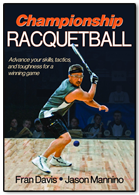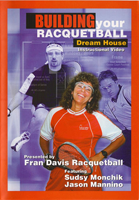 In every sport, positioning is everything and racquetball is no different. In racquetball, being in the right place at the right time is critical to giving yourself the best chance of getting to the ball a majority of the time and doing something with it once you get there, whether to defend or to score. Generally, the person who owns and controls center court has a greater chance of winning the match. This strategy is key.
In every sport, positioning is everything and racquetball is no different. In racquetball, being in the right place at the right time is critical to giving yourself the best chance of getting to the ball a majority of the time and doing something with it once you get there, whether to defend or to score. Generally, the person who owns and controls center court has a greater chance of winning the match. This strategy is key.
Because 80-90% of all balls that are hit wind up in the back half of the court, center court is in the middle of the back half of the court, which is approximately a 6-foot-by-6-foot area behind the dotted line.
Use the techniques in my book Championship Racquetballto understand center court (Chapter 5, page 137; Chapter 7 page 194) to understand the strategy of controlling center court.
I advocate controlling center court even to my “Championship Team,” Paola, Rocky, Taylor, Sharon, Connor, Jordan, Spencer, Lexi and Brian. Let’s examine what tools Rocky, Paola, Jason and all of my athletes use to “control center court” by taking a closer look at all 3 sides of The Sports Racquetball Triangle: Conditioning, Mental, and Physical Skills
Left Side of the Triangle
Conditioning
It is not okay to just be in center court without controlling center court, which means you must be down and ready in an athletic stance. If you are down and ready, you will be able to move to the ball more quickly and hit a shot that puts your opponent as far away from center court as possible.
Rocky & Paola’s focus on power & strength along with balance is the key to their success of owning and controlling center court.
Use the techniques in my book “Championship Racquetball” (Chapter 10) to learn more about power & strength as well as balance.
Nutrition
Being in control of your diet and water intake is just another component to learning how to be in control. If you learn how to be in control off the court you will have a better chance of being in control on the court. The more disciplined your are at eating the right foods to give you the proper energy and drinking the right fluids to keep your muscles hydrated, the more you can think clearly on the court and focus on controlling center court.”
Rocky, Paola and Jason’s eating and drinking habits are second to none: They all eat a very clean diet and drink no less than two 2 liter bottles of water throughout the day during heavy training days as well as during tournaments.
Right Side of the Triangle
Mental Skills
The latest research suggests that we play our best when we control our emotions. Keeping emotionally calm and centered means there is no psyching up or psyching down these days. An athlete wants to be calm, centered, and emotionally still for the purest responses and accuracy. Too much hype is distracting and upsets accuracy and timing. The fastest responses come from a still, calm, and relaxed body.
Jason became the master at being in control:
If you watched Jason when he played at the IRT Pro Stops he showed lots of emotions and would even make a few comments to the ref, but was able to immediately regroup, get back to being in control, and not stay upset.
More details on controlling your emotions can be found Chapter 9.
Base of the Triangle
Physical Skills
In order to control center court you must become a consistent player so you can call upon those particular shots that will move your opponent out of center court into the back court, preferably behind you. Once you come proficient at drop-and-hit and the basic set-up-and-hit, you want to build on your drilling combinations:
-one set-up shot at a time with one type of return at a time
-one set-up shot at a time with a different type of return at a time
-different set up shots at a time with the same type return at a time
-different set up shots at a time with different type returns at a time
Paola’s drilling sessions are like no other:
“I have added the drills above to my practice sessions as they help me to incorporate my drop and hit stationary drills into now moving drills which assimilates a game situation, allowing me to “control center court” like I need to in order to be the #1 player in the world.”
There arevarious ways to drill, practice and play to improve your game in Chapter 8 of my book Championship Racquetball..
ALL of my players from the professionals I coach, led by Rocky and Paola, to the amateurs I coach know the value of “controlling center court.” They know just how IMPORTANT being in control is and only concern themselves with staying in control and being focused.
Next issue I will continue to build your Championship Racquetball Game one level at a time so you too can be ready to become the champion you always dreamed of, but now you will have the tools to do it and make it a reality. Rocky ‘s and all my athletes “Championship Racquetball Games” stem from their focus on ALL 3 sides of the triangle working together so they can develop into top competitors. Without a shadow of a doubt, they KNOW just how important it is to do the work. They are living proof it works and their titles substantiate it.
For details on more personalized instruction, a weekend camp, instructional DVD’s, our book, Championship Racquetball, and our APP (coming soon), ALL which covers all aspects of the Sports Racquetball Triangle and more, please visit www.FranDavisRacquetball.com.Fran Davis is a 2004 racquetball Hall of Fame inductee, Racquetball Woman of the Year 2009, Coach #2 International Racquetball Tour (IRT) Pro Player, Rocky Carson; Coach #1 Women’s LPRT Pro Player, Paola Longoria; Coach Jr. World & National Champion, Intercollegiate Champion, & IRT Pro Player, Taylor Knoth; Coach Intercollegiate Champion & LPRT Pro Player, Sharon Jackson; Master Professional Instructor/Coach USAR-IP.










